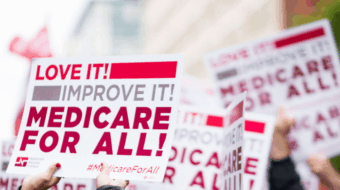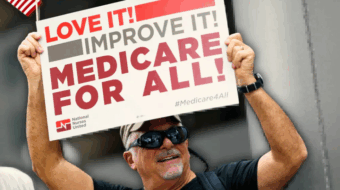The class struggle is the most basic, fundamental and important fact of life. The conflict between working people and corporate power permeates all aspects of society – the economy, politics, ideology and culture.
Why is this, and why can’t the two sides just call a truce and live in peace? Because the nature of the capitalist system divides people into opposing camps with irreconcilable interests and forces the fight. The workers who comprise over 80 percent of the population create the wealth, but the corporate owners and financiers take the lion’s share.
According the U.S. Department of Labor, for every $4 in new wealth created in manufacturing, workers get $1 (in wages and benefits). The corporate forces get $3. Put another way, during a 40-hour week workers create the value they are paid in 10 hours, and for 30 hours they work without pay, creating wealth for the bosses.
This is the origin of the class struggle. A vast, but finite, amount of wealth is created by the workers and a conflict arises over its distribution. Whatever the workers get, the capitalists don’t get, and vice versa. The workers seek to sustain themselves and their families. The capitalists have lavish lifestyles and are not motivated by consumer needs. They are motivated by the competition they face from the rest of the capitalist class. They are driven to get maximum profits. They cannot be magnanimous to their employees without being squeezed out by less scrupulous competitors. This is the law of the capitalist jungle and the values that flow from that are the values they seek to impose on society.
The workers must fight back to survive. Unlike the capitalists they have few resources. Their strength is in numbers, unity and organization. They reject the “each person for themselves” ideas of the bosses and form unions, self-defense organizations that include everyone and work for the common good.
But fighting simply in the economic arena of grievances, contracts and strikes does not solve the problem. The capitalists are able to use their power in the political and broad economic arena to take back wage increases through taxes, rents, interest, insurance and inflated prices for goods. Through various stratagems, the companies renege on promised pensions and benefits. They resist laws to make the workplace safe and healthy.
Similarly the workers must battle the corporations over who gets taxed and how the revenues are used – whether to benefit working people and the great majority in terms of education, health care, public services, in cultural and scientific development, or whether to fund wars launched on various pretexts to expand the realm of corporate power and profits.
The corporations and their mouthpieces scream about the evils of “big government,” by which they mean any regulations or programs that benefit the working class and people, but they avidly promote all forms of corporate welfare in the areas of research and development, incentives to go overseas and especially military spending.
Thus workers are forced to fight and find community allies in the broader political and social arena.
They find they must contend with a powerful ideological onslaught seeking to keep them isolated, divided, discouraged and defeated. They are encouraged by powerful media to avoid and fear those who differ from them in race, language, religion, age, gender, sexual preference, or immigration status. They are lectured by professors that they are irrelevant and admonished by preachers to be meek, obedient and respectful of the powers that be. They are presented with negative images of themselves by degraded corporate culture. Winning the class struggle therefore means fighting for principles of unity, solidarity and equality – ideas that send the capitalists into a frenzy of hatred, contempt and fear.
The fact that it pervades all aspects of society and its outcome determines the conditions of life is the basis for the powerful generalization stated by Karl Marx and Friedrich Engels in the opening lines of the Communist Manifesto: human history is the history of the class struggle.
This is also the basis for saying the class struggle is an objective reality. Despite claims by corporate spokesmen to the contrary, the class struggle is no one’s invention. It is not created or instigated by “subversives.” It goes on and has gone on for thousands of years in all times, places and situations regardless of whether anyone is even conscious of it. Left, progressive individuals and organizations rarely in fact have the power or influence to call the shots or determine the battle lines.
Because class oppression pervades everything, grassroots fightback movements continually arise. Some are small or narrow; some are very large and broad. Some are short-lived or transient; others, like the fight for equality and against racism, go on for generations.
But all are ultimately rooted in the exploitation of the working class by the capitalist class and because of that all have the potential to broaden and deepen to the point that they can upset the entire applecart. It is out of these movements that class and socialist consciousness arise and that the most effective and far-sighted leaders emerge.
Of particular importance are those movements which are led or deeply invested in by organized labor. Of all the people’s movements labor is the largest, with the greatest resources and experience, and the movement that most directly challenges corporate power. Particularly in the recent period the labor movement has been a magnet around which all other important democratic forces have gravitated. Labor has emerged as the leader of a broad, progressive social movement.
The class struggle pervades everything but in each political period all fights tend to gravitate around central battles. In these major battles both sides mobilize the largest proportion of their resources and troops. The role of labor and its allies becomes critical.
Throughout 2009 and into the spring of 2010, the focus of the class struggle in the United States was the battle for health care reform. The issue was to extend access to health care to the tens of millions unable to afford private insurance. Many progressive groups and individuals had ideas on how to do this. Some advocated a national health care system such as exists in England where hospitals are run by the government, doctors and health care workers are government employees and access is free to all. Many others called for extending Medicare to everyone, like the “single-payer” system in Canada where hospitals and doctors are private, but the government pays the bills.
But that is not where the battle lines were drawn. In the end they were not even drawn around the modest proposal for a “public option,” where government-run insurance would compete with private companies. The battle lines were drawn around the reform and regulation of the existing private insurance system, and the battle was fierce. The insurance companies flooded Congress with lobbyists and poured millions into the fight.
The Republicans spread every possible lie – the reform meant “death panels,” government takeover and socialism. Together with Fox News and right-wing talk jocks they spread racist poison and incited disruptions of town hall meetings by so-called “tea baggers,” some carrying arms.
The Republicans were not simply doing the bidding of the insurance and drug companies. They also saw this as a way to defeat the Obama administration politically and set back the entire progressive promise it represented. It was to be Obama’s “Waterloo.”
On the other hand labor and its allies mobilized their resources. Rallies, forums and demonstrations were held. Phone banks were mobilized. Lobbying went on by mail, Internet and in the halls of Congress. Democratic officials and the president himself hit the campaign trail. Obama’s coalition of labor and its progressive allies on the one hand and the liberal Democrats on the other held firm and understood what was at stake.
All the forces of progress were arrayed on one side and all the forces of reaction were on the other.
In the end the battle was won by the narrowest of margins. It was a huge victory for the working class and people and a huge defeat for the ultra-right.
The forces of progress did not determine the battle lines but they fought on the side of the working class once the battle lines were drawn. As the old labor song says: “Where workingmen defend their rights, that’s where you’ll find Joe Hill.”
Joe Hill, symbolizing the most progressive, militant and dedicated members of the labor movement, does not dismiss the actual battle at hand as not sufficiently advanced. He does not go off and do his own thing. He stands shoulder to shoulder with the workers wherever they choose to fight.
“The Communists,” says the Manifesto, “have no interests separate and apart from the working class as a whole. They do not set up any sectarian principles of their own, by which to shape and mold the working class movement.”
But in the framework of the ongoing class struggle Communists have a dual role. T hey fight “for the attainment of the immediate aims, for the enforcement of the momentary interests of the working class.” But, in addition, “in the movement of the present, they also represent and take care of the future of that movement.”
In fighting for reform and regulation of the insurance companies, Communists and other progressives also represented the fight for future advances in health care and defended the ability of the people to fight the next battles against the corporations and the ultra-right. No one could say to them: where were you with your advanced ideas about health care and socialism when we were fighting for reform and the survival of the Obama presidency?
No sooner were the votes counted and the Republicans defeated in their effort to turn health care reform into Obama’s Waterloo, than they launched their next assault with the strategic goal of regaining control of Congress in the midterm November elections. That immediately became the next focal point of the class struggle.
The fact that this comes down to a fight between Democrats and Republicans is not something that progressives choose and many of the Democrats with whom we are allied have serious shortcomings. But that is reality. That is where the battle lines are drawn. Like it or not, that is where the class struggle is being ferociously waged. Too much is at stake. We have no choice but to fight.










